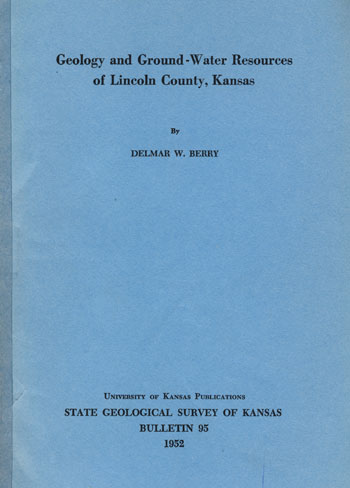Geology and Ground-Water Resources of Lincoln County, Kansas
By Delmar W. Berry
with a chapter on the chemical quality of the ground water
By Walton H. Durum

Originally published in 1952 as Kansas Geological Survey Bulletin 95. This is, in general, the original text as published. The information has not been updated.
You may also wish to visit our web site on the Lincoln County geologic map.
Abstract
This report describes the geography, geology, and ground-water resources of Lincoln County, north-central Kansas. The hydrologic and geologic data were obtained in the field during the years 1947 to 1950. Records for 175 wells were collected and 43 test holes were drilled to determine the thickness and character of the water-bearing materials. These data were used to prepare a water-table contour map for the major valley area and to determine the depth to water level in the county. The outcropping rock formations were studied in the field and by aid of test-hole data, and from these studies a geologic map and cross sections were prepared.
The area covered by this report lies in the Smoky Hills Upland area and is drained by Saline River, a tributary to Smoky Hill River, by Smoky Hill River, and by Rattlesnake Creek, a tributary to Solomon River. In general, the drainage pattern is fine-textured and the area is maturely dissected, small flat areas occurring along the terraces of the major valleys and at a few places on the upland divides. The climate is subhumid, the normal annual precipitation being slightly less than 25 inches. The principal mineral resources of the area are ground-water, construction materials, ceramic raw materials, and volcanic ash.
All the rocks exposed in Lincoln County are of sedimentary origin and range in age from Cretaceous to Recent. The oldest Cretaceous rocks exposed at the surface are Gulfian in age and are represented by the Dakota formation. Other Cretaceous rocks that are exposed in the uplands of the county are Graneros shale, Greenhorn limestone, and Carlile shale.
"Algal limestone" of the Ogallala formation (Pliocene) caps some of the highest hills.
Deposits of silt, sand, and gravel of the Meade formation (early Pleistocene) are exposed in the southwest comer of the county, where they overlie the eroded surface of the Dakota formation. The Sanborn formation of Pleistocene age mantles the flat upland areas, and alluvium underlies the channels of the major streams and their tributaries.
Supplies of potable water adequate for domestic and stock use are obtained from the alluvial fill of the valleys, and water supplies of variable quality and quantity are obtained from sandstones in the Dakota formation.
Saline River and Rattlesnake Creek are permanent streams in the area; nevertheless, wells supply all water for domestic and municipal uses. The City of Barnard obtains its water supply from a well penetrating the alluvium of Rattlesnake Creek, and Lincoln and Sylvan Grove obtain water supplies from wells penetrating the Dakota formation. Although adequate supplies of water for small irrigation projects may be obtained from the alluvium in local areas, supplies are generally not adequate for extensive irrigation.
A discussion of the principal chemical constituents of ground water in relation to the use and geologic occurrence of the water is based on analyses of 116 samples of ground water. These range from moderately mineralized hard water in both the Pleistocene deposits and the Dakota formation to highly mineralized hard water in other stratigraphic units. Soft water (less than 50 parts per million hardness) is pumped generally from deep wells in the Dakota formation.
Water containing more than 2,900 parts per million dissolved solids was obtained from one well in the alluvium; these dissolved solids may be related either to surface-water pollution or to the upward movement of more highly mineralized water from underlying formations. Most of the waters are hard; in all but four samples the hardness exceeded 130 parts per million.
Approximately 62 percent of the supplies have some domestic use. Undesirably high amounts of nitrate, in excess of 45 parts per million, were observed in 27 percent of the supplies sampled. Undesirable quantities of iron are present in the water of both shallow and deep wells, and the fluoride content in some samples from deep wells in the Dakota formation exceeds recommended limits for drinking water. A brief discussion of the municipal supplies is presented in this report.
Kansas Geological Survey, Geology
Placed on web March 5, 2009; originally published July, 1952.
Comments to webadmin@kgs.ku.edu
The URL for this page is http://www.kgs.ku.edu/General/Geology/Lincoln/index.html